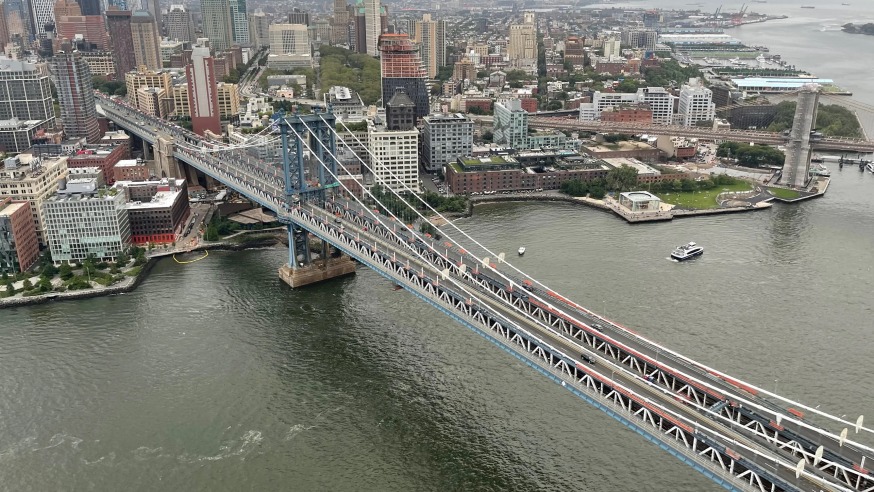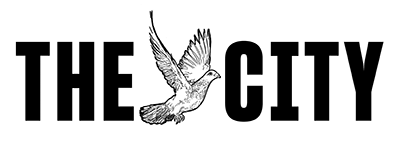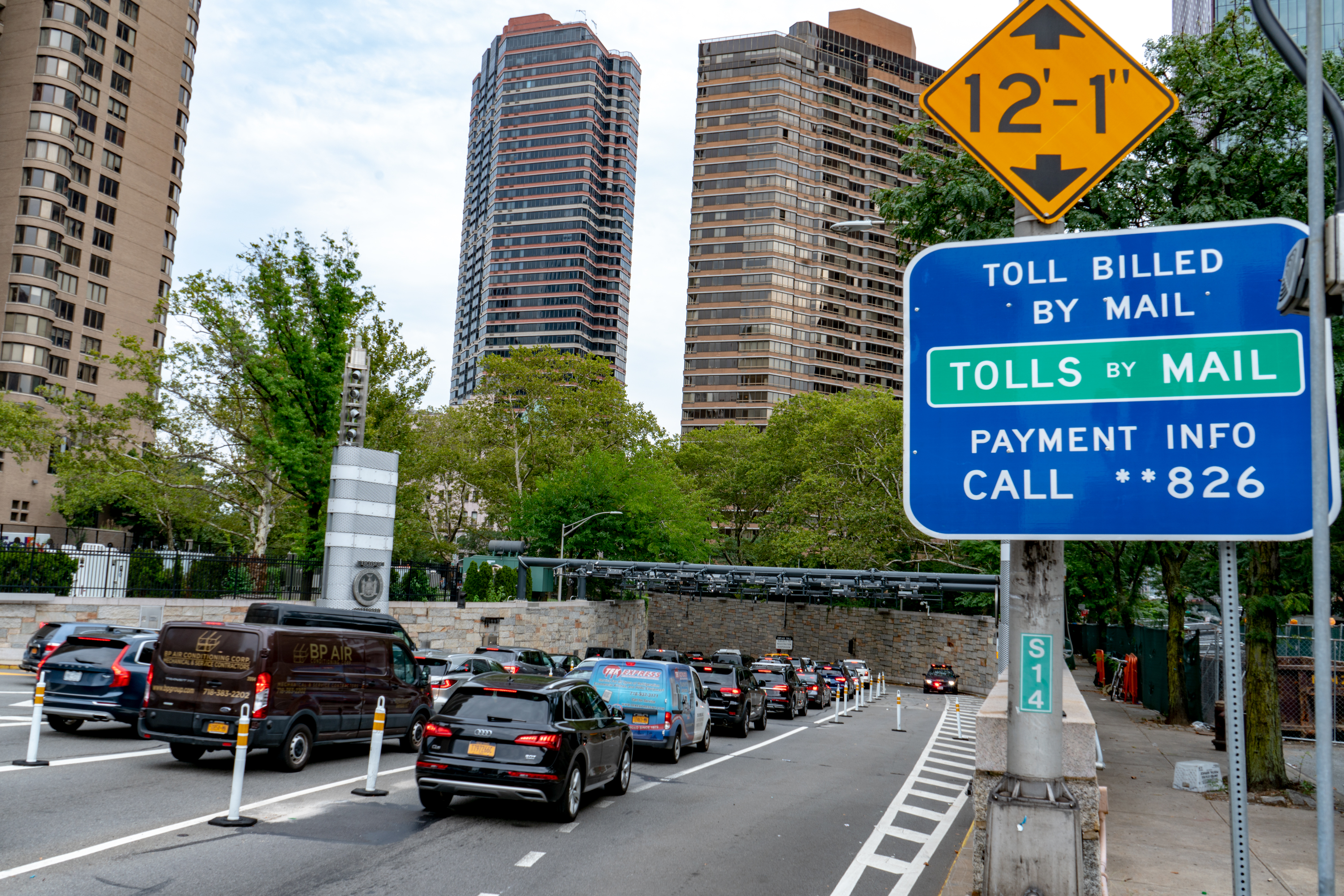
A view from above the Manhattan Bridge | Jason Scott Jones/THE CITY

This article was originally published
by The CITY on Sept. 15
BY Rachel Holliday Smith
As people slowly return to Manhattan’s commercial centers and climate change keeps punching the city in the gut, the push for so-called congestion pricing to help reduce traffic-related emissions is gathering steam.
The idea’s been kicked around by politicians and transit advocates for years but never tried anywhere in the United States. A bill from Albany gave New York’s plan the green light in 2019, but a lack of action by the Federal Highway Administration under then-President Donald Trump delayed the program.
Now, as traffic surges again, a critical player for the concept, New York’s new governor, Kathy Hochul, has signaled her full support for the idea. The Biden administration is behind it, too. So is Mayor Bill de Blasio, a latent fan.
And starting in late September, the MTA will begin a series of hearings to kick off an environmental review that could be the final hurdle for the plan.
Janno Lieber, the MTA’s new chairperson and CEO, said at Wednesday’s MTA board meeting the transit agency has “turned a corner” on the plan.
“We’re really now engaged — on the cusp of going 100 miles an hour, pardon the pun — in this public review process, which will open the door to the implementation of congestion pricing,” he said.
If you need to get up to speed on what this all means, whom it will affect and when we may actually see congestion pricing in New York, here’s a guide.
What is congestion pricing?
Think of it like any bridge or tunnel toll — without the river.
The idea: You charge people money to drive in certain places. That fee, in theory, discourages some drivers from getting on the road, potentially reducing overall traffic.
A primer from the U.S. Department of Transportation calls the pricing scheme “a way of harnessing the power of the market to reduce the waste associated with traffic congestion.”
What might congestion pricing look like for Manhattan? And how much will it cost me?
The city’s congestion pricing system — dubbed the “Central Business District Tolling Program,” or CBDTP, by the MTA — would affect all streets and roadways south of 60th Street, with three exceptions:
- —The FDR Drive
- —The West Side Highway
- —The sections of the Battery Park Underpass and Hugh Carey (Brooklyn-Battery) Tunnel that connect the FDR Drive to the West Side Highway
Here is a map of what that looks like, via the MTA:

Via the MTA
How much would it cost drivers?
The exact price of the toll has not been set. But previous proposals suggested between $12 and $14 per car and $25 for trucks, City and State reported. (By comparison, London’s congestion pricing fee is £15 or just over $20.)
The toll would be paid via E-ZPass or by mail for people without it, the MTA has said.
The 2019 law passed in Albany giving the green light for the program says that passenger vehicles should be charged only once per day. It also allows for “variable tolling,” or toll rates that change at certain times of the day or on different days of the week, depending on traffic.

Jason Scott Jones/THE CITY Traffic at the Queens-Midtown Tunnel
How will the system keep track of all of that? We don’t yet know, exactly.
But we have a glimpse of what officials are looking for from TransCore — the Tennessee-based company contracted by the MTA to build out the congestion pricing system in New York — according to the “request for proposal” the agency created in July of 2019.
THE CITY obtained that 3,022-page document (which you can read in full here, if you dare) through a source’s Freedom of Information Law request. Here are some highlights:
- —The system must be able to “detect and identify vehicles entering the CBD,” or Central Business District below 60th Street, by their class and size.
- —It must incorporate “optical character recognition” technology to be able to read license plates and identify vehicles.
- —Transcore must make sure that all the physical parts of the tolling system, likes poles and signage, have minimal interference with “the public’s sightlines, view corridors and open spaces.” The firm should use existing infrastructure where possible and avoid installing equipment in front of landmarks.
- —The contractor is charged with minimizing horizontal surfaces in new tolling structures “that might be susceptible to pigeons.”
Why do this? What will New Yorkers get out of it?
Fifteen billion dollars.
That’s how much money the state legislature mandated the MTA must raise through congestion pricing — by leveraging annual revenue to borrow $15 billion for the transit agency’s current five-year capital program.
That cash goal is laid out in the 2019 MTA Reform and Traffic Mobility Act, which allowed the program to proceed.
“They have to, by law, set tolls that are going to raise $15 billion for the capital program,” said Rachael Fauss, senior research analyst at the advocacy group Reinvent Albany. That money would in turn fund big-ticket items and infrastructure projects needed by the transit system.
But money isn’t the only reason to do congestion pricing, advocates say.
The greener goal is to cut down traffic, which will make faster rides for those still on the road while reducing some vehicle air and noise pollution. In pushing for congestion pricing, the MTA cites a federal study of traffic tolling elsewhere in the world that found carbon dioxide emissions dropped by double digits in both London and Stockholm after those cities adopted the policy.
“We have to really challenge ourselves to make big changes because what we are facing is an existential crisis,” said Renae Reynolds, executive director at the Tri-State Transportation Campaign, noting recent extreme weather. “It is not conducive to any of us to squabble over a congestion pricing toll when we are facing rising tides.”
Who will actually have to pay in the congestion zone?
The 2019 congestion pricing law passed in Albany made tolling applicable to all cars, trucks and vehicles in the zone except three categories:
- —Emergency vehicles
- —Vehicles transporting people with disabilities
- —Any vehicle belonging to families living inside the Manhattan congestion pricing zone in which the household earns $60,000 or less per year. (The cost of the tolls would be returned to them as a tax credit.)
According to Danny Pearlstein, policy and communications director for the Riders Alliance, other exemptions could be added to the mix by the yet-to-be-created Traffic Mobility Review Board (more on that later) and, finally, MTA’s board before congestion pricing hits the road.
The TMRB may also decide on whether to create special rules for for-hire vehicles, which — reminder — are already charged to drive south of 96th Street in Manhattan, including yellow cabs ($2.50 per ride) and app-based cabs like from Uber or Lyft ($2.75 per ride).
Leaders from around the tri-state area have pushed for toll loopholes.
Queens State Sen. David Weprin, a longtime opponent of the tolling plan, has pushed for zero tolling for New York residents, and police union leader Pat Lynch has called for no tolling for law enforcement employees who drive to work. A New Jersey Congress member recently introduced legislation that would block federal funding to New York if Garden State drivers are subject to congestion pricing tolls.

Hiram Alejandro Durán/THE CITY Traffic heads up 10th Avenue in Manhattan, July 23, 2021.
Too many exemptions could undermine the purpose of the system, Pearlstein said.
“The legislation requires the MTA to raise a certain amount of money, which means that if you’re not raising it for one group, you have to raise it more heavily from another group,” he said. “The fairest thing to do is to have a robust program that treats as many people as possible the same, recognizing that no one has — except for these tiny categories — more of a claim to drive into the Central Business District than anybody else.”
Skeptics of congestion pricing — including de Blasio, before he came around on the idea — have knocked the tolling as a regressive tax, i.e. a fee that hits poorer people harder because it’s a bigger chunk of their earnings. But it’s a bit more complicated, as this report from City Limits explains.
Where did congestion pricing come from?
Congestion pricing has been implemented in several major cities, including London, Stockholm and Singapore. But the idea was born in New York.
The father of congestion pricing was William Vickrey, a Nobel Prize winner and Columbia University economist who proposed the concept of charging drivers to reduce traffic back in 1959, according to The New York Times.
It’s been talked about in the city, off and on, for decades. Responding to federal pressure over air quality standards in the 1970s, mayors John Lindsay and Ed Koch tried various traffic bans and tolls during their administrations.

Kristen Artz/New York City Mayor’s Office Then-Mayor Mike Bloomberg in December 2011.
Mayor Mike Bloomberg proposed his own congestion pricing scheme for the city in 2007, but lawmakers in Albany quashed it a year later.
The current system, as outlined in the 2019 Act, is the result of pressure from then-Gov. Andrew Cuomo who called for a congestion pricing scheme after years of inaction on the idea. His change of heart came in the aftermath of the transit system’s “Summer of Hell” in 2017 and ongoing budget woes.
What needs to happen before we’ll see this on the streets? And when might it take effect?
Starting in late September, the MTA will begin public hearings as part of its 16-month environmental assessment period. You can get more information about how to give input or attend one of those meetings here.
At the MTA’s Wednesday board meeting, the agency laid out details of its environmental review plan, which included outreach to 28 counties in three states, including Connecticut and New Jersey, and “five tribal nations.”
If the assessment finds there is no significant impact from the congestion system and the federal government signs off, the project can proceed to the hard part: Determining the final list of who gets tolled, how much it will cost and the mechanics of how it all gets charged and maintained.
That work will be done by the as-yet-unformed Traffic Mobility Review Board, or TMRB, made up of six people — five appointees from the MTA and one from the mayor. (De Blasio already chose his TMRB representative, Department of Finance Commissioner Sherif Soliman, but the next mayor could replace him. All six slots are effectively up in the air.)
The traffic board’s recommendations will go to the MTA’s board for final approval — and since the MTA board is typically controlled by the governor, a lot of the power over the final implementation of the congestion pricing rests with whoever is top dog in Albany.

Kristen Artz/New York City Mayor’s Office Then-Mayor Mike Bloomberg in December 2011.
“I’ve got hope in Hochul,” said Reynolds. “Although things are moving slowly, the ball is rolling.”
Of course, Hochul may not be the governor whenever congestion pricing sees the light of day. The MTA chose a longer environmental review period than the federal highway administration said was necessary, pushing possible implementation of congestion pricing until after the 2022 gubernatorial election.
So it may easily be another couple of years before New Yorkers see street tolls go into effect in Manhattan’s core, at the earliest. And that’s barring some kind of lawsuit, said Pearlstein.
“Someone will sue,” he said. “If they sue when the system is about to be turned on, that could add months. It could add years.”
THE CITY is an independent, nonprofit news outlet dedicated to hard-hitting reporting that serves the people of New York.
One Comment

This process is politically sensitive. Congestion Pricing may not kick in until January 2023. Even this date may not hold. If vacancies on the MTA Traffic Mobility Review Board continue to remain (Governor Hochul needs to fill five positions) and the environmental review process takes even longer, the MTA will miss the revised forecasted January 2023 start date for Congestion Price Tolling. This was suppose to have raised $15 of the $51 billion MTA 2020 – 2024 Five Year Capital Plan. The MTA stated that they need 16 months rather than four months to complete the federal NEPA environmental review process. Final details of who will pay still need to be established. Elected officials will lobby for discounts or exemptions for police, fire, teachers, low income, outer borough residency, seniors, physically disabled. small commercial delivery businesses, users of electric vehicles or other special niches. These discounts or exemptions will be adopted to placate the constituents of elected officials running for reelection in 2021 or 2022. You can’t capture five years of toll revenues estimated to be $1 billion per year (leveraged to raise $15 billion in support MTA’s $51 billion 2020-2024 five year capital plan) when you implement the program three years or more after 2020.
(Larry Penner — transportation advocate, historian and writer who previously worked for the Federal Transit Administration Region 2 New York Office. This included the development, review, approval and oversight for over billions in grants to support MTA, NYC Transit subway, bus & Staten Island Rail, Long Island and Metro North Rail Roads along with 30 other transit agencies in NY & NJ).